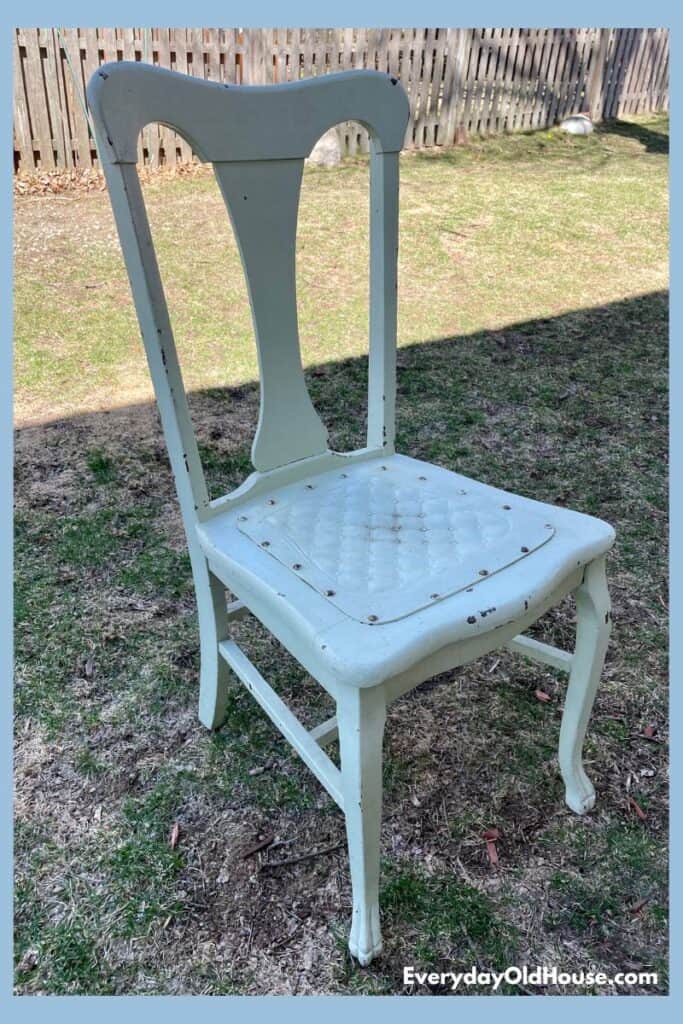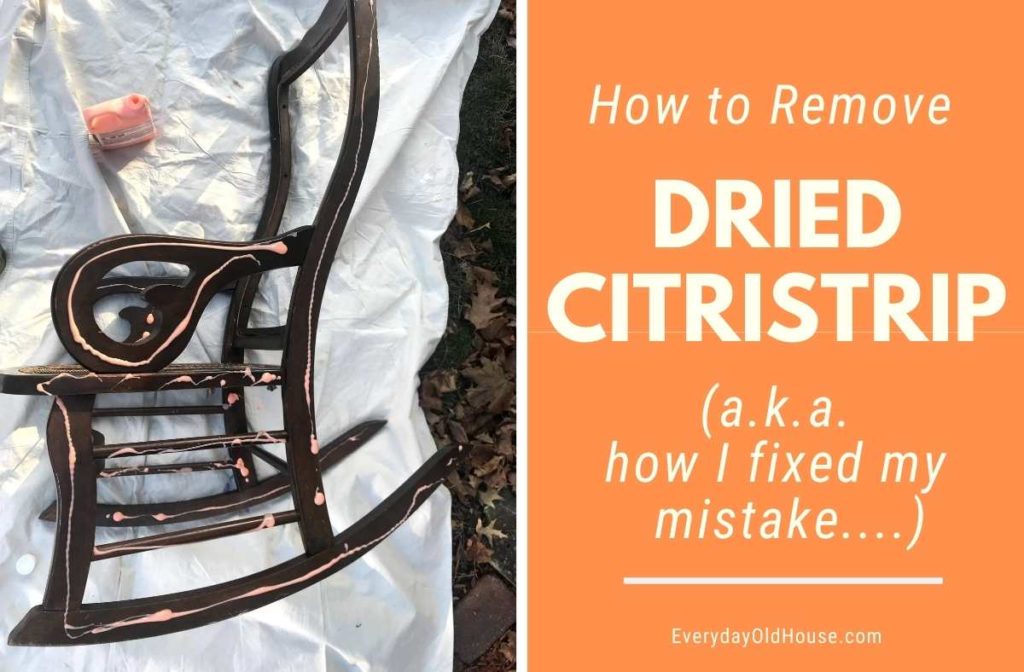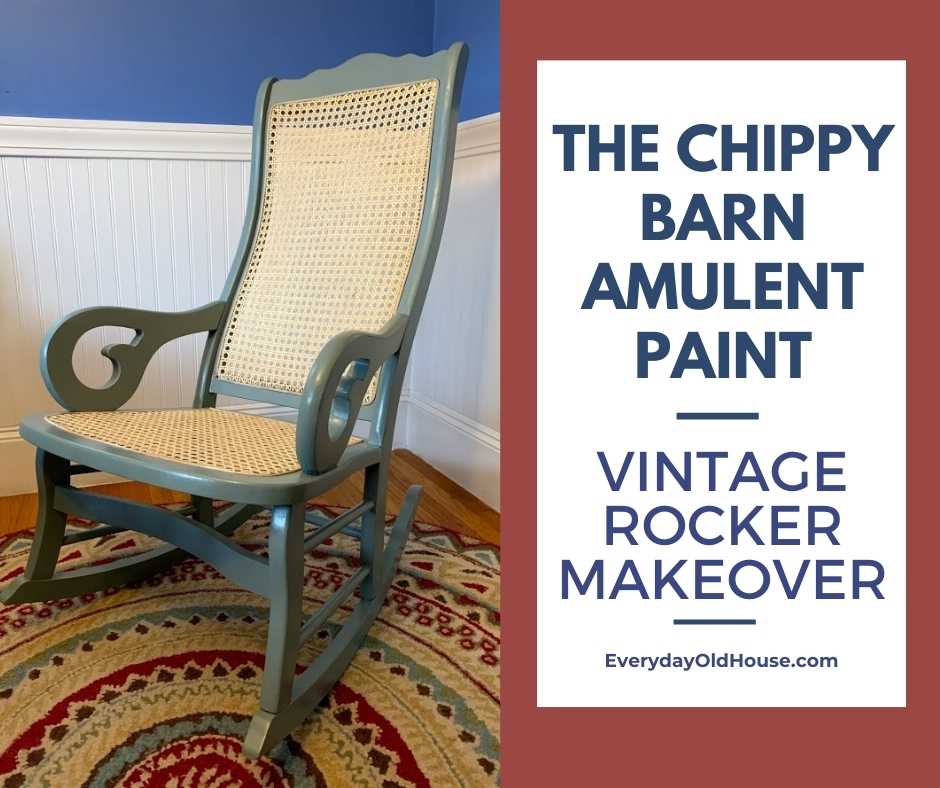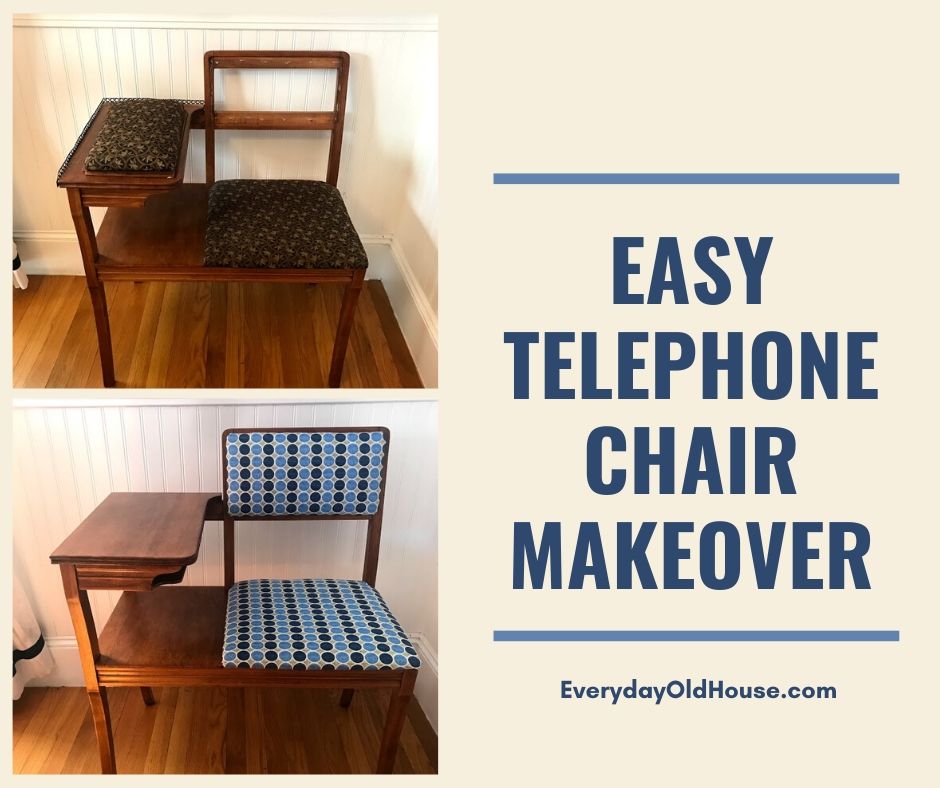Last Updated on January 4, 2024
Refinishing vintage furniture is a rewarding hobby. BUT sometimes it can be a real pain in the you-know-what. Especially when that furniture has years of caked-on paint begging to come off. But what is the most effective, fastest, and safest way to remove paint for old wood furniture? Let’s find out…

This post contains affiliate links, including but not limited to, Amazon Associates. As such, I earn from qualifying purchases. Full disclosure located here.
Apparently there are 3 main optionf for removing paint from old furniture: sanding, heat gun, and chemical stripper. If you’re a newbie like me, you might feel a bit overwhelmed by which direction to go in. So I’ve decided to solve that problem by:
- Learning more about these 3 paint removal methods
- Outlining their pros and cons
- Creating an easy-to-use, one-page printable Comparison Sheet to help me decide.
Get ready to say goodbye to that tired, chipping paint and hello to some seriously stunning furniture.
Backstory
I’m a sucker for old wood furniture abandoned on the side of the road. Currently, my basement is FILLED with vintage furniture waiting for a new lease on life. A chair with ripped caned seat, high boy bureau with mirror, even an old steamer trunk.
Honestly, it’s more projects than I could finish in a year.
I’m trying to be good and pass on new projects. Over and over, I promise my husband that I won’t bring any more furniture home to stuff into the basement.
But then I walk around my neighborhood and something catches my eye, patiently waiting on the curb….

At first glance, it’s a simple chair. I can ignore that and move along right? But then I make the mistake of looking closer. See those feet? So cute, right? How can I let it sit here on the curb as the trash truck is coming down the street?

The leather seat insert? Oh, I’ve replaced those before. That’s easy.
But removing all that the paint? I’m not 100% sure how to quickly yet effectively (and safely) remove….
How to Easily Remove Paint from Old Wood Furniture
Ideally for this chair, I want to completely strip furniture of old paint and begin with a baby-smooth, bare wood surface.
Maybe under all those layers, maybe the wood will have a gorgeous tiger oak grain, or will be good enough to stain and protect with Danish Oil. Or perhaps the wood is a hot mess and I’ll just paint it again.
But I’ll never know until I try to remove the paint, right?
Before You Start: 3 Essentials
But first, keep these 3 tips in mind before you remove paint from old wood furniture:
1. Prep Furniture
Before you start the paint removal process, remove any hardware (knobs, handles, hinges, etc.) from the piece.
And if a piece of furniture is damaged, consider whether it makes sense to repair it before OR after you strip it.
2. Lead Test
Lead-based paint was prevalent in the United States until it was banned due to its toxicity in 1978. With old furniture there is a chance it might have lead-based paint and may need to take additional precautions.
The easiest way to test is to use a lead-testing kit found at most local hardware and big box stores. It’s simple to use. Simply swab the surface of an item, and the swab changes color to indicate lead.
3. Pre-Test Removal Method
Before diving into one of the paint removal methods below, test it out first. Find an inconspicuous spot and try it out to ensure it will efficiently and effectively remove paint (AND won’t damage the furniture).
3 Ways to Remove Paint from Wood Furniture
The three most common ways to remove paint from old wood furniture are:
- Heat Guns
- Chemical Stripping
- Sanding
With each paint removal method, there are pros and cons to consider. Let’s take a look at what methods work best in certain situation, and when they don’t.
Don’t forget to download the Comparison Sheet at the bottom of this post to help you decide which approach to take on your old piece of furniture.

Heat Guns
Heat guns work by simply applying heat to the paint. Paint softens at high temperatures and lifts away from the wood so that you can easily remove it with a scraping tool.
Think of it as a high-powered hair dryer that will melt the paint right off the furniture.
Pros: Heat Guns
1. Less Mess
Unlike sanding (which creates a dusty mess) and chemical strippers (that drip everywhere), heat guns are less messy. The waste generated only consists of the stripped paint shavings, making cleanup faster and easier.
2. Removes Multiple Layers
Heat guns remove several layers of paint at once. If you use the right technique, heat will seep through all the old paint layers, resulting in a simultaneous removal of all layers. But just remember – the thicker the layers, the longer you have to point the heat gun…
3. Economical
Heat guns are cheaper than both chemical strippers and sanders. And they can last for many years.
Besides a new scraper every now and then, there is nothing else you need to buy for future projects. No sandpaper. Nor another can of stripper.
4. Hits Nooks & Crannies*
This pro has an asterisk because is effectiveness in reaching hard-to-reach places is debated amongst the expert DIYers.
Some feel that heat guns are a perfect fit for removing paint from nooks and crannies in furniture. It just takes the right technique of adjusting the heat gun nozzle at the right angle and picking the right scraper (or steel wool). However, other DIY experts struggle with using heat guns to remove paint from detailed work.
Cons: Heat Guns
1. Char Furniture
One of the largest cons of using a heat gun to remove paint from old wood furniture is the ability to damage the furniture. If you hold the heat gun in one place for too long, you can scorch and blacken the wood.
There is a learning curve for using a heat gun. There is a skill to knowing how far away to hold the heat gun as well as the right temperature to effectively remove paint without charring the wood.
Oh, and doing this all with the paint gun in one hand, and the scraper in the other.
Without burning yourself….
2. Fire Risk
Since this is, well, a heat gun, you also need to be concerned with the risk of fire. If you hold the heat gun to wood too long, you might actually start a fire. Yikes!
Take basic precautions of having a working fire extinguisher nearby. And prep ahead of time for potential breaks by having a metal tray handy in case you need to set the heat gun down.
3. Long Time
With a heat gun, you can only work in one small area at a time, versus chemical strippers that can be applied to an entire piece at once. Therefore, unless you have a lot of time to kill, you might not want to use a heat gun for larger pieces of furniture.
4. Finicky Paint Type
Heat guns appear to be more finicky towards what type of paints they remove. Meanwhile, sanding and chemical strippers are less discriminatory.
Interestingly, there are a variety of opinions on what types of paints don’t work well with heat guns. Some say heat guns are not a good match with oil-based paint, while others maintain water-based paints.
My opinion? If you are leaning towards using a heat gun, try it out on a small, inconspicuous area of your furniture and decide for yourself.
5. Lead-Based Paint*
This con for using heat guns to remove paint from old wood furniture is in asterisk. Why? Because I couldn’t find a consensus on whether or not using a heat gun to remove lead-based paint was hazardous or not to human health.
Some websites said the temperature reached by heat guns was high enough to volatile lead into the air where it could be inhaled. Other websites said no.
My advice? As mentioned above, test your furniture for lead and then make an educated, conscious decision on whether or not you are comfortable using a heat gun to remove paint.
Chemical Stripper
Quite simply, chemical strippers are thick liquids, gels, or pastes that peel paint away from surfaces, including wood. Once applied, chemical removers sit on the furniture for a set period of time, allowing the paint to bubble and loosen from the surface making it easily removed via scraper or steel wool.
There is a variety of chemical strippers on the market using different base ingredients to activate paint removal that fall into these 3 main categories:
- Caustics
- Biochemical (citrus- and soy-based)
- Solvents
There’s a lot we could go into on these paint strippers, but I’ll save that for another post. In the meantime, here are the pros and cons:
Pros: Chemical Stripper
1. Ease of Use
Chemical paint strippers have an easier learning curve than the other two methods to remove paint from wood furniture. And it’s harder to damage a piece of furniture with a chemical stripper, then, say a heat gun applied too long and charring your furniture.
Simply apply, wait until the paint bubbles, and then scrape off paint and wipe with a wash.
2. Reaches Nooks & Crannies
If you’re removing paint from a piece of furniture that has intricate detail, chemical strippers are a better option for getting into those nooks and crannies and doing its job.
3. Minimal Active Time
Chemicals strippers have a different process for removing pain than sanding and heat. Unlike sanding and heat guns, which require you to actively remove the paint, chemical strippers do most of the work for you. These chemical removers are especially efficient for larger pieces of furniture like hutches and bureaus.
Goop up the piece with the stripper, grab a coffee and wait for the magic to work (but DON’T wait too long as you can read about my mistake with Citristrip).
4. Effective on Most Paints
Chemical strippers reportedly tend to work on a variety of paints – latex, water-based and oil-based. It’s not as finicky as heat guns.
5. Safer for Lead
If you’re dealing with old paint that contains lead, chemical strippers are one of the most effective methods for removing it safely. There is no dust nor paint chips generated so you don’t need to worry about inhaling contaminated dust.
Cons: Chemical Stripper
1. Messy
I can’t sugar-coat it, so here it goes: Chemical strippers are messy. They drip, they run. They stain clothes. It can get everywhere. It’s not pretty.
Be sure to protect your work area by covering it with plastic or an old sheet. Have lots of rags handy. And have a waste can or to collect all that gooey mess (including the paint chips)!
2. Costly
While the initial cost of a hear gun or sander is higher, ultimately chemical strippers tend to be more expensive. Why? First, you need to continue to buy chemical stripper for future projects – it’s not reusable. Second, you need A LOT of stripper to goop onto your furniture to be effective. And that doesn’t count re-application if there are multiple layers of paint.
Speaking of which….
3. Reapply for Multiple Layers
Chemical strippers are not as effective as removing multiple layers of paint at once. It may require two or three (hopefully not more!) applications depending on the thickness and quality of the paint.
And if there are multiple layers of paint to remove, it might take a significant amount of time to finally see that gorgeous bare wood.
4. Safety*
Ok, so this one I’m going to put an asterik on. There is a lot of online debate about the toxicity of chemical strippers on the market.
Here’s the skinny. Many years ago, all chemicals strippers were bad… They contained an extremely toxic chemical called methylene chloride. It ate through paint like nobody’s business BUT also caused dangerous health effects like cancer.
Luckily, now there are several safer options. And I’m not going to go into what is safer for our health and the environment in this post. I’ll save that for another day.
My advice is to do research – read the ingredients on the labels of various chemical strippers. And regardless of the stripper you chose, always follow manufacturer safety recommendations at a minimum. Protect your eyes, skin, wear a respirator or have sufficient ventilation. Even if it’s labeled as eco-friendly and safe, just remember, there’s still something in that stripper that’s strong enough to eat paint…
Sanders
Sanding is an old-school method of removing paint from old wood furniture. It requires using an electric hand sander (i.e. belt, palm or detail sander) to grind down the layers of paint until reaching the bare wood underneath.
Here’s a breakdown of the pros and cons.
Pros: Sanders
1. Works Quickly
For large, flat pieces of furniture (i.e., tables and dressers) it is an extremely efficient way to remove paint.
2. Removes Multiple Layers
With the right equipment and technique, you can remove several layers of paint at once using a sander.
3. Reusable Equipment
If you already have a sander, you won’t need to invest in any additional equipment for this method besides sandpaper. Sanders are a tool most homeowners should have in their arsenal since they can be used for a variety of other projects.
4. Effective on Most Paints
Sanders tend to work effectively at removing a variety of paints – latex, water-based and oil-based. LIke chemical strippers, sanders aren’t as finicky as heat guns.
Cons: Sander
1. Dusty & Messy
Sanding generates A LOT of dust. Dust all over your workspace. On your clothes. In your hair. And that’s not fun to clean up.
If you choose to sand, you must prep your workspace to contain the mess or consider sanding furniture outdoors.
In addition to protecting your work area, take precautions for your own health with personal protective equipment like glasses and particle respirator or mask.
2. Lead-Based Paint Concerns
If your furniture was painted with lead-based paint, then the dust created through sanding could contain lead. And that you DON’T want to inhale.
If your piece tests positive for lead, be sure to choose the appropriate particle mask, or use a different paint removal method.
3. Physical & Time Demands
With sanding, you work the sander. And while I’m not the weakest person on earth, I’ll admit that sanding requires more physical effort than you expect. Be ready to roll up those sleeves and put a bit of oomph or elbow grease, because you are going to work hard at removing that paint.
4. Higher Initial Investment
Above I mentioned the pro that sanders are handy to have because they can be re-used for several other home maintenance projects,. But compared to the other two ways to remove paint from old wooden furniture, sanders are more expensive at the onset.
However, once you buy a sander you will likely use it for years on future pieces. The only maintenance cost is sandpaper.
4. Unreachable Nooks & Crannies
Removing layers of paint from small detail work on furniture is a challenge for sanders. The other two methods are more effective in sneaking into those hard-to-reach crevices and working their magic.
Comparison Sheet
Removing paint from old wood furniture – what’s the verdict?
Hopefully after reading the above you have learned that ultimately it all depends on the size, detail of your furniture as well as the type of paint that you want to remove.
Click the below pdf to download the Comparison Sheet. Refer to it at the beginning of every project to ensure choosing the most effective and safest way for paint removal!
For example, if you’ve have large flat surfaces that need paint removal, then sanding or chemical stripper might be the way to go. But if the piece tests positive for lead, then you might steer clear of sanding.
Or, if you’re dealing with multiple layers of paint and the piece is small, a heat gun might be your best bet. But if you can’t remove stubborn bits of paint in the nooks and crannies even with the heat gun, you might opt for a layer of chemical stripper.
Wait, do I just mention using more than one way to remove the paint from old wood furniture? Yup, I just did. Did I blow your mind? ?
In the end, it’s all about what works best for you and your vintage furniture. But no matter which method you choose, just remember: be safe, be patient, and have fun!
Related Posts
Want to be the first to know about new posts? Be sure to follow me on Pinterest, Facebook, Instagram or Twitter of even Etsy! Or better yet… Subscribe below!
My monthly (admittedly sometimes more, sometimes less….) emails are like receiving a unexpected letter from an old friend WITHOUT needing to put on your slippers and walk out to your mailbox…. See? I got ya, my friend!)
[Note: My posts are proudly connected to these amazing link parties full of DIY ideas and inspiration!]


